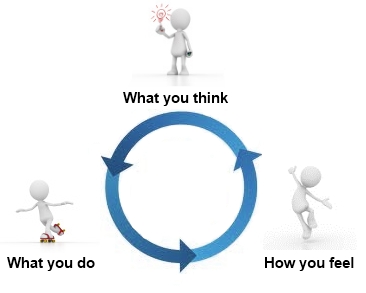Cognitive Behavioral Therapy Cognitive Behaviour Therapy in its simplest form can be broken down into the following concept:
Throughout the course of therapy a great deal of time is spent investigating thoughts. At this point you might be asking, “Why would we spend time on thoughts?" When we have a problem that is interfering with our lives, there will be negative (or unhelpful) thoughts present. In order to change how you feel and what you are doing you will need to:
We will also need to replace these thoughts with healthier thoughts. Replacement thoughts, a.k.a. healthier thoughts, are very important. If you do not replace your negative or unhealthy thoughts, it will be much more difficult to eliminate them. As you are working on your thoughts you will be asked to learn and practice coping skills to address your feelings and to help change your behaviour. Let’s look at an example Here is picture of what CBT looks like:
Why choose Cognitive Behavioral Therapy? As I stated earlier there are many forms of therapy used to treat the problems people experience. There has also been and continues to be a great deal of research on the effectiveness of these therapies. A major research question that has guided many years of study is, “Does therapy A significantly help the people it is being used on?” Researchers, therapists, insurance providers, and many other invested professionals want to make sure the therapy they are offering or that is offered is really the best choice. As a psychologist I am guided by the term “best practice”. Best Practice means that a lot of research has been conducted with a certain therapy and the results have been positive: People are helped by the therapy. For instance, to date the best practice guideline for children and teens facing anxiety and depression is Cognitive Behavior Therapy. What is research telling us about cognitive behavior therapy? As mentioned above two issues children and adolescents struggle with are anxiety and depression. In both cases cognitive behavior therapy has shown success. In a recent literature review Rapee, Schniering, and Hudson (2009) summarized among the most effective treatments for anxiety in childhood and adolescents is cognitive behavior therapy. There were significant results in studies that undertook therapy with just the child or adolescent and those which incorporated parents into treatment. Other literature reviews have found similar results. Compton, March, Brent, Albano, Weersing, Curry (2004) found the optimal treatment for children and adolescents with anxiety and depression was cognitive behavior therapy. These are just two literature reviews taken from a wealth of knowledge to illustrate what research has found and how best practice guidelines are established. References Rapee, R. M, Schniering, C. A., Hudson, J. L. (2009). Anxiety disorders during childhood and adolescence: Origins and treatment. Annual Review of Clinical Psychology, 5(3), 11-41. |
|
Home International Adoption Psychological Assessment Contact Anne Privacy Policy Site Map |


